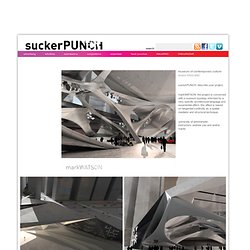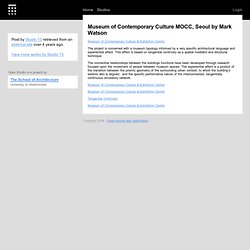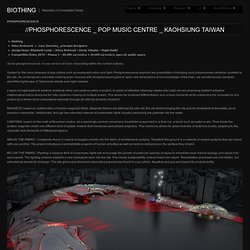

UNDER TOMORROWS SKY. Theoremas. The Nature of Code. Research_FranCastillo. Shrink Wrap with Grasshopper and Kangaroo. Museum of contemporary culture. London ENGLAND suckerPUNCH: describe your project. markWATSON: the project is concerned with a museum typology informed by a very specific architectural language and experiential affect. this affect is based on tangential continuity as a spatial mediator and structural technique. university of westminster instructors: andrew yau and andrei martin the connective relationships between the buildings functions have been developed through research focused on the movement of people between museum spaces. the experiential affect is a product of the transition between the prismic geometry of the surrounding urban context, to which the building’s exterior skin is aligned, and the specific performative nature of the interconnected, tangentially continuous circulatory network.

Museum of Contemporary Culture MOCC, Seoul by Mark Watson from Studio 13. The project is concerned with a museum typology informed by a very specific architectural language and experiential affect.

This affect is based on tangential continuity as a spatial mediator and structural technique. The connective relationships between the buildings functions have been developed through research focused upon the movement of people between museum spaces. The experiential affect is a product of the transition between the prismic geometry of the surrounding urban context, to which the building’s exterior skin is aligned, and the specific performative nature of the interconnected, tangentially continuous circulatory network.
Best architecture model. Portfolio_DesignComputation. Eric Tse Columbia University GSAPP M.Arch Portfolio. Swarm What? Swarm What? Benjamin Bratton, 2012 What it is that designers actually mean when we/they talk about swarms, intelligence, and swarm intelligence? Usually we refer to rhythmic emergent processes –waves– but do this referring by sharing demonstrative images of swarm topologies, frozen or in motion. As information visualization becomes an increasingly global language of systems, events and trends, these images of swarm aggregation take on a more public and political assignment. f32 : francastillo. Advanced Design & Digital Architecture. Algorithmic design. Tectonic landscapes - [Ay]Architecture. Tectonic landscapes Central Park Competition, Lima, Peru, 2011 The project seeks to generate a spatial ground condition by manipulating the terrain onto a set of artificial topographies.
![tectonic landscapes - [Ay]Architecture](http://cdn.pearltrees.com/s/pic/th/landscapes-architecture-47977572)
Initial diagrams on the project served to establish a series of control points and lines creating an organizational bands system. Each band started to acquire local intelligence while establishing the overall landscape program for the park: the hardscape and softscape strategies. Therefore the project evolves from a 2dimensional existing ground condition towards a 3dimensional model.
Hardscape The depth, length and width of each landform are related to performance and program. Prototypical botanic gardens - [Ay]Architecture. Prototypical botanic gardens TEC de Monterrey, Campus Sonora Norte, Mexico, 2011 Landscape Design Conceptual Stage.
![prototypical botanic gardens - [Ay]Architecture](http://cdn.pearltrees.com/s/pic/th/prototypical-architecture-47977413)
Ground Organization. Find(&)MERGE. Bologna ITALY University of Bologna critics: Alessio ERIOLI (Studio Master); Tommaso CASUCCI, Filippo NASSETTI, & Alessandro ZOMPARELLI (tutors) suckerPUNCH: Describe your project. SVEN (Andrea BARBIERI, Filippo CONTI, Giulia MARIOTTI, & Beatrice SCARDOVI): Find(&)MERGE is a project that starts with the research of a coherent strategy that can be implemented regardless of changing conditions.
By exploiting systems emergent behavior we obtain a model that both fits and changes the area configuration where the system acts. CoDeLab Book. Computing Kaizen Studio Toys. Studio Toys Computing Kaizen Columbia University GSAPP Advanced Studio VI Interested in Processing and architecture?

Join the Proxy mailing list to get infrequent announcements. The "Computing Kaizen" studio explored evolutionary architectural structures and their potential to anticipate change and internalize complex relationships. The studio used Processing, an open source platform for writing computational "sketches", to create intelligent building blocks that could self-organize into innovative forms. Codelab. Processi di progettazione biodigitali in Architettura_Thesis_Tommaso Casucci. HYBIOS Hybrid Bio Structures Final Presentation. Hybridbiostructures. Phosphorescence. BiothingAlisa Andrasek + Jose Sanchez_ principal designersdesign team: Elizabeth Leidy – Alicia Nahmad – Denis Vlieghe – Rajat SodhiCompetition Entry 2010 – Phase 1 – 80,000 sq meters + 20,000 sq meters open air public space Sonar phosphorescence: A new version of iconic resonating within the current cultures.

Guided by the iconic features of pop culture such as exuberant colors and light, Phosphorescence explores the possibilities of bringing such polychromatic shimmer qualities to the site. Place cosandey - [Ay]Architecture. Place cosandey ROLEX Learning Center - Campus Masterplan Extension, EPFL Ecole Polytechnique Fédérale de Lausanne, Switzeland, 2012 Authorship CONVERGEO / HUANG & WALDVOGEL Le projet "Objectif Campus' est une réponse logique à l’évolution d’un campus qui vit de plus en plus 24h/24 et 365 jours par an. Cette initiative est centrée sur la communauté EPFL, et en particulier sur les étudiants de plus en plus nombreux en provenance du monde entier, correspondant à autant de cultures qu’il s’agit d’intégrer et de mettre en synergies. Mais ce projet est aussi une interface indispensable avec la Cité, en phase avec la responsabilité et le rôle que l’EPFL joue à l’échelle régionale. Reading Artificial Grounds Architectural Resolution.
Images. Synth[e]tech morphologies. [Research Project] Swarm Ornament. Project by Shih-Yuan Wang done with Processing The use of digital tools for architectural production is no longer a question and the impact of the digital on form-finding in architecture has been conspicuous.
![[Research Project] Swarm Ornament](http://cdn.pearltrees.com/s/pic/th/research-project-ornament-74592205)
Could designer work with computational algorithms that effect on the creative field? Spatial slur. Recently, development of the class library has focused on optimizing interactions between large populations of particles. Typically each particle is forced to perform a distance check between itself and all other particles in the system. From there it collects forces which are generally some function of this distance. In this case, computation time is proportional to the square of the particle count making large populations really chug. Enter spatial binning. When forces are only active within a finite range (ie. boids, packing etc.) checking every particle isn't really necessary.